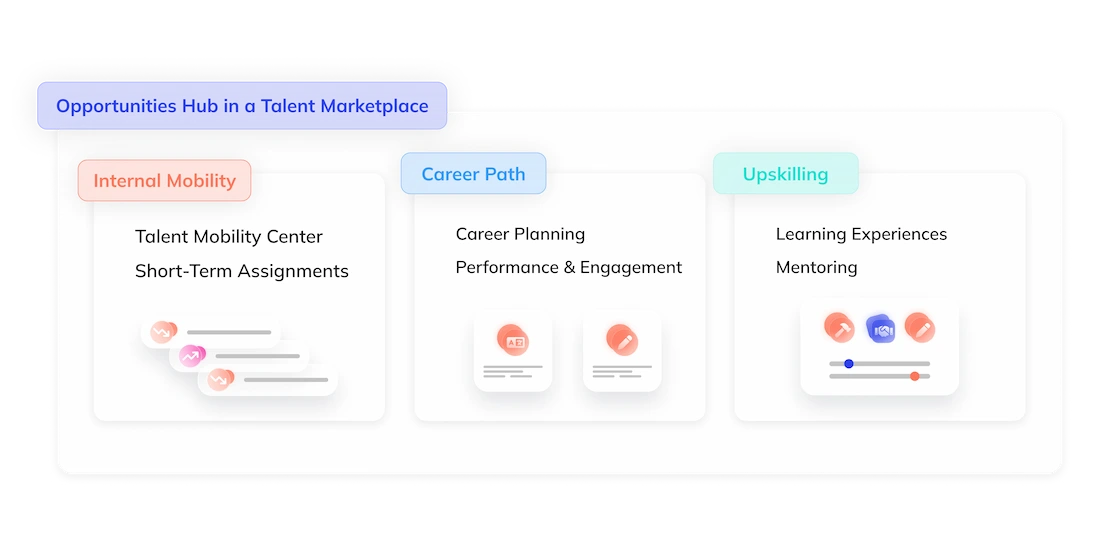Among the company's talent, the notion of internal mobility is very often limited to the possibility of moving into a management role. In reality,the opportunities for horizontal evolution are much richer, the challenge is to create the desire for mobility in employees.
From a management point of view, the awareness of freeing up access to various sets of skills has emerged with the organization of companies into networks and project teams. This is particularly illustrated in the challenges of allocating projects with the right expertise. Indeed, as they grow, team leaders face the challenge of identifying the right resources across the network.
Silos are no longer appropriate, managers need to benefit from an active and open internal pooling process. Does internal mobility allow for the development of employee talent? This article identifies best practices, describes the functioning of an Internal Talent Marketplace and all of the internal mobility tips that it concentrates.
Why do we talk about "internal talent mobility"?
This is notably the result of a generational effect: the new generations question their jobs more. This results in the construction of much less linear and "careerist" paths. We need to respond to the need for individualized career development, which, with the help of artificial intelligence, will facilitate these practices within HR teams.
Today, due to a lack of visibility and projection, many employees leave the company because they think that this will be the easiest and fastest way to progress. This is even the first reason given for resignation.
What are the figures for talent mobility?
Here are the main figures for internal mobility:
- 40% of employees stay longer in a company where internal recruitment is important.
- Internal hires are 20% less likely to leave their jobs in the first year.
- A significant saving compared to external recruitment (on average 18% more expensive)
- The speed of the recruitment process(20 days on average compared to 2 to 3 months externally).
How can we categorize the different professional mobilities?
- Vertical mobility by advancing employees to the next level. This mobility requires upskilling.
- Transversal mobility by moving skills from one trade to another, also known as "cross-skilling".
- Geographical mobility to develop an activity on another site.
Here are all our resources on these different themes:
- The various methods of ascending in skills
- The terms and conditions for the implementation of the Jobs & Skills Management
- The Guide to Mapping skills
What are the advantages of internal mobility for talent?
Feedback from our partners highlights 4 advantages of internal mobility of talents: they gain access to new opportunities, collaboration becomes more transversal, commitment increases and know-how is transmitted more systematically.
Access to new opportunities
The main advantage of internal mobility is that it opens up new opportunities for talent to evolve within the company without having to try their luck elsewhere. It also promotes feelings of accomplishment, recognition and belonging to the company, which are the primary motivating factors according to the theory of Herzberg, an American psychologist famous for his work on the enrichment of tasks at work.
Discover all the advantages of talent mobility in our complete Guide: The benefits of internal mobility.
Increased transversality of collaboration
The biggest risk for companies today is that teams and resources become siloed in their respective locations, markets and businesses. Pooling teams and resources while promoting internal diversity and inclusion will allow to offer attractive mobility solutions to employees and to move from a linear hierarchical logic to a business ecosystem logic.
Numbers that demonstrate improved talent engagement
The risk of not aligning new talent with the company's values and a major cause of contract termination within the first year. According to a Global Trends Linkedin study, internally recruited employees stay on average 41% longer than externally recruited skills . The longer employees who have moved internally have stayed with the organization, the higher this figure is. Other figures highlight a preference for transversal mobility because it allows them to capitalize on their knowledge of the company. According to a study by Hellowork and Hays, 75% of executives are in this situation.
Better transmission of know-how
Talent mobility is often part of high potential programs with interesting results. Consequently, this practice, when considered at scale, favors a transmission as well as a transversality of skills essential to create the necessary agility for the organization.
A policy of internal mobility also enables the company to anticipate needs by skills on the trades of the future or in tension. Indeed, many professions are undergoing a very rapid evolution of certain skills, which leads to an accelerated obsolescence of the company's reference systems and therefore of the associated training offers.
The Talent Marketplace as a lever for internal mobility.
A myRHine study indicates 3 key reasons why HRDs are not deploying internal mobility. Here are the numbers:
- The absence of a tool for 63% of the respondents
- Lack of involvement of managers: 70%.
- Passivity of employees: 40%.
These three reasons are to be completed by a cultural reason that sees the risk of making a mistake as superior to the benefit of achieving the expected result.
How to manage the internal mobility of your talents?
To frame and facilitate the internal mobility of talents, we recommend 5 actions. Start with an objective assessment, create a relay from your Jobs & Skills Management, base your recruitment on skills, simplify the internal recruitment process, introduce an adapted HRIS tool.
Creating a culture of mobility
Designed to make talents"actors of their own evolution", the main audience to address remains managers, who are the main obstacles to change according to 70% of HR decision makers. The participation of managers and HR in the enrichment of internal mobility tools is a success factor of the approach. This will make them want to get involved and reduce resistance to change.
Set up a dynamic around the Jobs & Skills Management
This approach means not only depending on the talent's requests for change, but also planning them as part of a genuine internal mobility policy. Defining the framework for career paths must remain flexible and allow for the possibility of new career paths, with one watchword: make the criteria for evolution objective and transparent. In this context, it is important to start by mapping the skills of employees and then to foresee the qualifications that will be necessary for the company's evolution.
Linking talent aspirations to available opportunities
Most companies forget to add to the assessment of qualifications the measurement of employees' aspirations according to the ways in which they collaborate, the assets they wish to put into perspective in their careers. A Talent Marketplace, regularly fed with continuous feedback from their local HR and their managers about their evolution wishes. This of course requires the pooling of different tools on a single platform.
Simplify the internal recruitment process
You will thus avoid the pitfall of cumbersome and opaque administrative procedures that lead to demotivation and frustration, encouraging an external search. It is also important to be transparent during mobility interviews, and to accompany employees when they refuse a move so as not to generate additional frustration.
Set up a Talent Marketplace
This software, which is becoming more and more widespread, allows them to clearly visualize their concrete prospects for evolution, to measure the evolution of skills and to create the trajectories that meet their aspirations.
Changing the rules for the common good
Internal mobility is still governed by a set of standards that are obsolete and need to be fundamentally rethought. Internal evolution figures are indicative of corporate strategy and are demanded by candidates. The evolution towards a diffusion of knowledge, made possible by a structured and opportunistic mobility of talents, will be made possible by bringing together several ingredients:
- A profound cultural change.
- A break down of silos.
- The implementation of a collaborative space for the valorization of opportunities.
We are aware of the changes that need to be made and we propose to lead them by thinking about the implementation of a Talent Marketplace that puts the power in the hands of HR actors and frees the collective potential.













